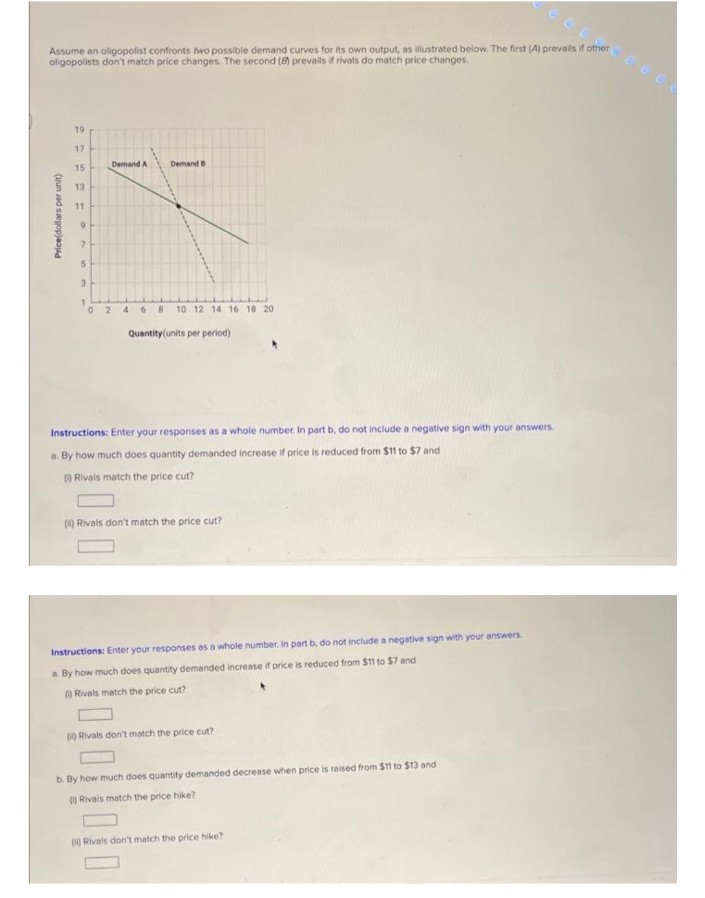Assume an oligopolist confronts two possible demand curves for its own output, as illustrated below. The first (A) prevails if other oligopolists don't match price changes. The second (8) prevails if rivals do match price changes. Price(dollars per unit) 19 17 15 13 11 N Demand A 0 2 Demand B 468 10 12 14 16 18 20 Quantity (units per period) Instructions: Enter your responses as a whole number. In part b, do not include a negative sign with your answers a. By how much does quantity demanded increase if price is reduced from $11 to $7 and () Rivals match the price cut? (i) Rivals don't match the price cut? Instructions: Enter your responses as a whole number. In part b, do not include a negative sign with your answers a. By how much does quantity demanded increase if price is reduced from $11 to $7 and () Rivals match the price cut? (4) Rivals don't match the price cut? b. By how much does quantity demanded decrease when price is raised from $11 to $13 and () Rivals match the price hike? (0) Rivals don't match the price hike?
Assume an oligopolist confronts two possible demand curves for its own output, as illustrated below. The first (A) prevails if other oligopolists don't match price changes. The second (8) prevails if rivals do match price changes. Price(dollars per unit) 19 17 15 13 11 N Demand A 0 2 Demand B 468 10 12 14 16 18 20 Quantity (units per period) Instructions: Enter your responses as a whole number. In part b, do not include a negative sign with your answers a. By how much does quantity demanded increase if price is reduced from $11 to $7 and () Rivals match the price cut? (i) Rivals don't match the price cut? Instructions: Enter your responses as a whole number. In part b, do not include a negative sign with your answers a. By how much does quantity demanded increase if price is reduced from $11 to $7 and () Rivals match the price cut? (4) Rivals don't match the price cut? b. By how much does quantity demanded decrease when price is raised from $11 to $13 and () Rivals match the price hike? (0) Rivals don't match the price hike?
Managerial Economics: A Problem Solving Approach
5th Edition
ISBN:9781337106665
Author:Luke M. Froeb, Brian T. McCann, Michael R. Ward, Mike Shor
Publisher:Luke M. Froeb, Brian T. McCann, Michael R. Ward, Mike Shor
Chapter16: Bargaining
Section: Chapter Questions
Problem 16.1IP
Related questions
Question

Transcribed Image Text:Assume an oligopolist confronts two possible demand curves for its own output, as illustrated below. The first (4) prevails if other
oligopolists don't match price changes. The second (8) prevails if rivals do match price changes.
Price(dollars per unit)
19
17
15
13
11
9
7
5
3
0
Demand A
Demand B
2468 10 12 14 16 18 20
Quantity (units per period)
Instructions: Enter your responses as a whole number. In part b, do not include a negative sign with your answers.
a. By how much does quantity demanded increase if price is reduced from $11 to $7 and
(Rivals match the price cut?
(1) Rivals don't match the price cut?
Instructions: Enter your responses as a whole number. In part b, do not include a negative sign with your answers
a. By how much does quantity demanded increase if price is reduced from $11 to $7 and
() Rivals match the price cut?
0) Rivals don't match the price cut?
b. By how much does quantity demanded decrease when price is raised from $11 to $13 and
() Rivals match the price hike?
(1) Rivals don't match the price hike?
Expert Solution
This question has been solved!
Explore an expertly crafted, step-by-step solution for a thorough understanding of key concepts.
This is a popular solution!
Trending now
This is a popular solution!
Step by step
Solved in 2 steps

Knowledge Booster
Learn more about
Need a deep-dive on the concept behind this application? Look no further. Learn more about this topic, economics and related others by exploring similar questions and additional content below.Recommended textbooks for you

Managerial Economics: A Problem Solving Approach
Economics
ISBN:
9781337106665
Author:
Luke M. Froeb, Brian T. McCann, Michael R. Ward, Mike Shor
Publisher:
Cengage Learning


Managerial Economics: A Problem Solving Approach
Economics
ISBN:
9781337106665
Author:
Luke M. Froeb, Brian T. McCann, Michael R. Ward, Mike Shor
Publisher:
Cengage Learning
